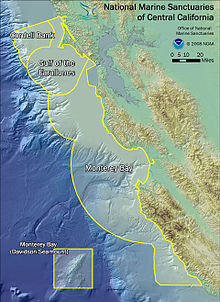 | |
| Agency overview | |
|---|---|
| Formed | October 23, 1972 |
| Jurisdiction | United States federal government |
| Headquarters | 1305 East-West Highway, Silver Spring, MD 20910 |
| Employees | 350 |
| Annual budget | $50 million (2016)[1] |
| Agency executive |
|
| Parent agency | National Oceanic and Atmospheric Administration |
| Website | sanctuaries.noaa.gov |



A U.S. National Marine Sanctuary is a federally designated area within United States waters that protects areas of the marine environment with special conservation, recreational, ecological, historical, cultural, archeological, scientific, educational, or aesthetic qualities.[3] The program was established in 1972 by the Marine Protection, Research, and Sanctuaries Act and is currently administered by the National Ocean Service through the National Marine Sanctuaries Act (NMSA).[4]
While National Marine Sanctuaries are multiple-use areas, the NMSA emphasizes that one of the express purposes of a sanctuary is to “maintain the natural biological communities” and to “protect and, where appropriate, restore and enhance natural habitats, populations, and ecological processes.” The National Marine Sanctuary System consists of 17 marine protected areas that encompass about 785,000 square miles (2,030,000 km2). Individual areas range from less than 1 to 583,000 square miles (3 to 1,509,963 km2).[5]
The Office of National Marine Sanctuaries (ONMS), a division of the National Oceanic and Atmospheric Administration (NOAA), administers the 17 national marine sanctuaries. The program began after the 1969 Santa Barbara oil spill off the coast of California brought the plight of marine ecosystems to national attention. The United States Congress responded in 1972 with the Marine Protection, Research and Sanctuaries Act which allowed for the creation of marine sanctuaries. The resources protected by U.S. national marine sanctuaries range from coral reef ecosystems in American Samoa, Florida, Hawaii, and Texas, to shipwrecks in the Great Lakes and the Atlantic Ocean.[6]
The NMSP also is involved in the administration of the Papahānaumokuākea Marine National Monument and the Rose Atoll Marine National Monument, although they are not U.S. national marine sanctuaries. The NMSP jointly administers the Papahānaumokuākea Marine National Monument in conjunction with the United States Fish and Wildlife Service and the State of Hawaii, and it jointly administers the Rose Atoll Marine National Monument with the U.S. Fish and Wildlife Service.
- ^ NOAA Budget Summary (PDF). United States Department of Commerce. Retrieved August 29, 2016.
- ^ "Leadership | Office of National Marine Sanctuaries". Office of National Marine Sanctuaries Leadership. National Oceanic and Atmospheric Administration. Retrieved September 13, 2024.
- ^ MPP 1, Angela M. Haren (May 25, 2007). "Reducing Noise Pollution from Commercial Shipping in the Channel Islands National Marine Sanctuary: A Case Study in Marine Protected Area Management of Underwater Noise". Journal of International Wildlife Law & Policy. 10 (2): 153–173. doi:10.1080/13880290701347432. ISSN 1388-0292. S2CID 216114235.
{{cite journal}}: CS1 maint: numeric names: authors list (link) - ^ "National Marine Sanctuaries Act and Legislation | Office of National Marine Sanctuaries". sanctuaries.noaa.gov. Retrieved October 18, 2023.
- ^ "National Marine Sanctuary Frequently Asked Questions". sanctuaries.noaa.gov.
- ^ Casserley, TR. "Torrid Seas to Icebound Lakes: Shipwreck Investigations within NOAA's National Marine Sanctuaries". In: Pollock NW, ed. Diving for Science 2009. Proceedings of the American Academy of Underwater Sciences 28th Symposium. Dauphin Island, AL: AAUS; 2009. Archived from the original on April 15, 2013. Retrieved March 6, 2013.
{{cite journal}}: CS1 maint: unfit URL (link)